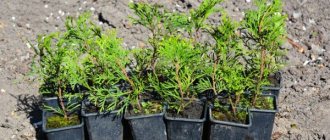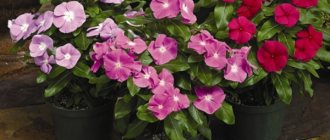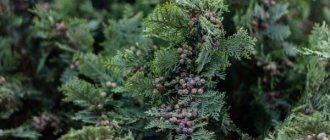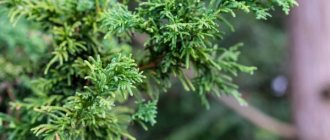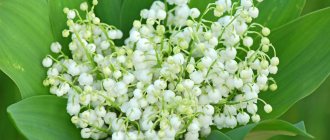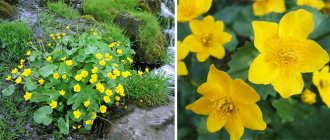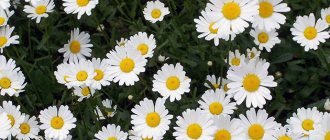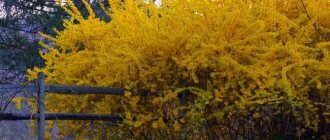Pachysandra is a deciduous or evergreen low-growing shrub from the Boxwood family. This plant is not particularly remarkable, but is valued for its unpretentiousness, stable appearance throughout the season and a neat ground cover for shady corners of the garden plot. Pachysandra blooms, like many ground-covering plants, not too brightly and noticeably, but it does not require much experience or hassle from the gardener in planting and care, perfectly performing its simple function.
Description and photo
Pachysandra has two separate habitats - in East Asia (China, Japan) and in North America, in a temperate climate. It has a very well-developed, far-reaching surface root system, thanks to which it can be used to strengthen slopes. This feature must be taken into account when planting it on the site. It has strong and durable, erect, non-lignified shoots, the height of which usually does not exceed 30-35 cm. The stems are leafy along their entire length, but in the tiered version, the leaf plates are medium-sized, short-petiolate, ovoid or oval in shape. Their surface is glossy, smooth, painted bright green in its basic form. The edges of the leaves are serrated, their arrangement is three-tiered.
The pachysandra flower has no decorative value; it is a small spike-shaped inflorescence of a pale light beige color, up to 5 cm long. The flowers on one plant specimen develop of different sexes, which facilitates the pollination process. During the flowering period, pachysandra exudes a subtle, pleasant aroma.
The fruit is a light-colored drupe, hardly noticeable in leaflets. The triangular-shaped capsules in which they are enclosed remain sealed even after final ripening, but in mid-latitude conditions the seeds do not have time to ripen.
Biological description of pachysandra
Pachysandra is classified as a separate genus of the Boxwood family. Found in temperate climates of North America and Asia (China, Japan). The plant is distinguished by a very long and developed root system, which is located superficially and covers large areas.
The stems of pachysandra are strong, erect, their maximum length is 35 cm. Oval or ovoid leaves are located along the entire height of the stem. The length of each of them is 3-6 cm, and the width is 2-4 cm. The surface of the leaf is glossy, bright green, the edges are serrated with a pointed end. The leaves are attached to the stem with short petioles (5-15 mm) and are arranged in three tiers. In total, one plant has from 5 to 10 leaves.
Pachysandra flowers appear in mid-May; they are not attractive. At the top of the stem, a small spike-shaped inflorescence grows, 3-5 cm long. It simultaneously contains male and female flowers. The top of the ear is covered with staminate buds 3-4 mm wide, from which stamens up to 12 mm long protrude. In pistillate flowers, two spiral-shaped columns are formed at once. The inflorescences emit a delicate, pleasant aroma.
Description of pachysandra species with photos
This genus is represented by only four varieties, of which one has a deciduous life cycle, and the other three remain evergreen. Within the species diversity there are several ornamental garden varieties.
Pachysandra apex
This is the most famous and widespread variety in culture, originating from the Japanese Islands. Remains green all year round, has dark, rich foliage color. The height of the clump is no more than 20 cm, while the plant actively spreads in breadth. The leaves are dense, closely spaced by cuttings, thin, but with fleshy veins that make them prominent, and arranged in distinct tiers. The stems and veins have a slight reddish tint. The shape of the leaf blades is obovate and partly rhombic, their edges in the upper part are rounded-toothed. Small inflorescences form on the tops of last year's shoots. Their color is beige or greenish, with a slight purple tint. A frost-resistant variety that can withstand temperatures down to -28C without shelter. Blooms in the second half of spring.
The most decorative varieties of this variety:
- "Greencarpet" is a low-growing variety (about 15 cm) with bright foliage.
- "Green Shin" - curtain height is 12-17 cm, the foliage is very bright, shiny, decorative.
- "Silveredge" is a variegated variety with a narrow silvery-white stripe along the edge of the leaf. Shoots up to 20 cm.
- “Variegata” - in this variety the stripe does not have smooth edges, creating the impression of spots. The variety is very sensitive to cold and more demanding of light than others.
Pachysandra japonica
The height of the bushes is about 15 cm. The leaves are ovate, glossy, rounded-toothed in the upper part. Remains green for two years.
Pachysandra axillaria
A relatively tall evergreen shrub, characterized by strong branching of shoots. The height of the bushes is from 30 to 45 cm. Young shoots of short-petioled leaves have whitish pubescence. The leaves themselves are grouped in tiers closer to the top. Usually does not rise above 10 cm. The flowering is inconspicuous, represented by small axillary inflorescences only 2.5 cm long. The buds are white with a weak aroma.
Pachysandra prostrate (recumbent)
It is widespread in the southeastern regions of North America. It is the only deciduous representative of the genus; it completely sheds its foliage every year. The height of the shoots is average, about 30 cm. Their color is dominated by purple-brown tones. The leaves are light green, wide, with large teeth along the edge. Small green-brown spots may be scattered throughout them. The entire aboveground part, except for the flowers, has short whitish pubescence.
One of the valuable qualities of pachysandra is its ability to resist the growth of weeds; the bed with this plant does not need weeding.
Species diversity of plants of the genus Pachysandra
- Pachysandra apical or Japanese (see description above);
- Pachysandra terrestris. It is an evergreen plant native to southeastern North America. The most numerous growth of this type of pachysandra is noted on the banks of the Agelleini River. This is where the second name of the flower, Euphorbia Agelleini, comes from. The stems of this species are thinner than those of apical pachysandra and can lie down. The leaves are oval in shape, have a pointed tip and a jagged edge at the top of the leaf. In winter and early spring, the leaves acquire a purple hue, on which silvery specks are located, and in summer they become bright green;
- Pachysandra axillaria. An evergreen subshrub common in China. The height reaches up to 50 cm. The leaves resemble the leaves of apical pachysandra. However, the flowers have bright pink petals with many white stamens.
Planting and care
Pachysandra is a plant grown in open ground. It is not used as an indoor cultivar, but is often planted in containers to decorate outdoor areas (gazebos, terraces, barbecue areas, balconies). Due to its good adaptation to a temperate climate, it grows well in central Russia, where it is used to decorate park areas, trunk circles of large non-fruit trees, and framed flower beds and garden paths. Planting pachysandra on loose fertile soil does not even need to be fertilized. The plant also does not need frequent watering due to the fact that it usually grows in shady places where moisture is well retained.
Lighting
Semi-shaded places are optimal for planting pachysandra, but even in full shade the plant will not look depressed. The only exceptions are variegated varietal varieties. In particular, the variagated form is the most demanding of light.
Landing
Pachysandra are extremely unpretentious to the soil. They grow on light and fertile soils or heavy, soggy loams. The main requirement is acidity. The plant selects neutral or slightly acidic soils.
Pachysandra thrives in partial to full shade. The exception is the variegated form. To keep its multi-colored crown colorful, it needs sun. The plant tolerates frost well; it is sheltered in the northern regions of the country. During the first winter, the young shoots should be covered with fallen leaves.
For perennials, damp, but not wetlands are chosen; systematic feeding is not needed. Resistant to pests and diseases. After transplantation, the bushes grow poorly for a couple of years. But from the third season they become an impenetrable carpet.
Landing
There are three ways:
- Grains. Propagation by seeds is a long and painstaking task. The grains are sown in late autumn and the crops are covered for the winter. Sparse shoots will grow in the spring. The formation of the root system of seedlings takes 2-3 seasons, and they will bloom only in the fifth year.
- Planting with petioles is an elementary and uncomplicated technique. To do this, you need to cover the strong shoots with soil. Roots will appear on them quickly.
- Propagation by cuttings of rhizomes. Take powerful pieces of rhizome with a restoration bud. The segments are planted in ditches, deepened by 3-4 cm and at a distance of 20 cm from each other. This method helps the bush grow quickly.
Does not tolerate direct sunlight, prefers shade. If planted in the sun, the leaves will fade. Requires watering after rooting. Withstands severe cold up to 30 degrees. Can't stand the wind. For planting, take turf and leaf soil mixed with sand in an amount of 2:1:1. The plant does not require fertilizing.
Reproduction
It multiplies by crushing the bush, with the help of pre-rooted petioles or parts of roots that have a restoration bud, at the start of spring or at the end of summer. The roots are placed in depressions up to 3-4 centimeters deep and buried. The distance between the pits is from 20 to 25 centimeters. The flower will grow in one or two seasons. It can also be propagated by grains. Plants grown from grains bloom in the 3rd-5th season.
Diseases and pests. Pachysandra is not damaged by diseases and pests.
Pachysandras are very undemanding to soil. They grow on light and fertile substrates or heavy, soggy loams. The main requirement is acidity. The plant prefers neutral or slightly acidic soils. It is believed that on light soils the clumps will grow wider faster.
Pachysandra thrives in partial shade or fully shaded areas. The exception is the variegated form. In order for its variegated foliage to be bright, it is necessary to provide access to the sun.
Planting in pots
The plant tolerates frost well and only needs shelter in the northern regions. In the first winter, young shoots should be sprinkled with fallen leaves. After overwintering, it will become a good fertilizer.
Perennials prefer moist, but not swampy places and do not need regular feeding. Resistant to parasites and common diseases.
Some gardeners note that after transplantation, the bushes do not grow well during the first two years. But from the third year they turn into a solid carpet. Young stems from root buds can be located at a considerable distance from each other. To obtain a continuous cover, you should divide the roots and plant them more often. To force pachysandra to grow, you can trim the tops of the stems.
We invite you to familiarize yourself with: Garden primrose perennial planting and care
Pachysandra can grow in any soil. Both soils enriched with nutrients and poor, clay soils are suitable.
It is important to know: it is necessary to take into account that the plant is demanding on soil acidity. Pachysandra needs soil with a neutral or slightly acidic reaction.
As for lighting, the plant does not need sunlight. It is best to grow Pachysandra in shaded areas. The exception is the variegated variety of the crop. It needs the sun for the brightness of the foliage.
How to plant:
- Before planting plants, their roots must be kept for a short time in a solution of a growth stimulator.
- It is best to plant in early spring.
- It is not recommended to plant seedlings too deep into the ground.
Pachysandra is used to decorate gardens, parks, and courtyards. Plant it in shady places where there is a lot of moisture. Prefers looser soil. Before planting, the plant is kept a little in water with the addition of a solution to enhance growth, then it is planted in the soil, but not deeply. In the sun, the plant loses its color, its beautiful emerald color. It is preferable to plant it in early spring, then it will take root better.
Vegetative propagation
Where there are already planted plants, the easiest and most reliable way to propagate pachysandra is by vegetative methods - dividing the bush and cuttings. Cuttings can be taken at any time of active growth, but preferably not during the flowering period. It is recommended to divide the bush in the fall, before budding begins. The cuttings, the resulting sections of the bush with rhizomes, are immediately dropped into fresh, moist, fertile soil.
Cut cuttings are also immediately planted in the soil without pre-treatment. It is permissible to place them in a jar of water to activate the growth of new roots. This plant takes root quickly and easily, after which the above-ground part begins to develop within a short period of time.
Reproduction
Propagating pachysandra for summer residents provides great pleasure, since everything is done very easily and quickly. The plant reproduces in two ways: seeds and rhizomes. Propagation by seeds does not always work. And if it does, the seedling grows slowly and blooms only after four years. More preference is given to propagation by rhizomes, since rhizomes are better developed and grow faster.
Propagated by cuttings of rhizomes with a renewal bud exclusively at the end of summer, it can also be propagated by cuttings.
The plant does not need replanting. It grows in one place for a long time. Therefore, transplantation is carried out only when necessary. However, it should be remembered that the first couple of years after transplantation the plant grows slowly. Only three years later the culture begins to grow, forming a continuous carpet.
The plant propagates by the following methods:
- rhizome segments;
- cuttings;
- seeds.
Stem cuttings are used for cuttings. This is a very simple method of propagation. The cuttings just need to be sprinkled with soil. They take root quickly.
Propagation by rhizome segments is carried out either in August or March. They are planted no more than 4 cm deep. The distance between the planted segments should be about 20 cm.
Tip: the plant reproduces by seeds is problematic. Even if the plant germinates, it will grow very slowly.
The crop is practically exposed to diseases and attacks by insect pests.
Pachysandra can reproduce in two ways:
- Seeds. Characteristic is the fact that in our country pachysandra cannot produce seeds. If you purchase seeds separately and plant them, the plant will sprout slowly and unevenly. It blooms only in the third or fourth year of its life cycle.
- Sections of rhizomes. In early spring, a section of the root with a bud is cut off, after which it needs to be covered with a 2-4 centimeter layer of soil. The distance between the roots should be ten to fifteen centimeters. For faster growth, you need to do this manipulation every year, otherwise the plant will grow only in the place where it was planted.
Propagation of pachysandra by seeds
Self-collection of seeds is possible only in warm climates. In the middle zone they, as a rule, do not ripen. Seeds are sown in the fall immediately in open ground so that they undergo high-quality natural stratification. However, the landing site requires additional shelter in winter. The first shoots that appear in the spring can be very disappointing with their rarity, but you should be patient; in a couple of years the clump will become lush and beautiful.
Even if not all the seeds germinate, those seedlings that have sprouted can quickly catch up with proper care. 2-3 years will pass, and due to the rhizomes developing and producing offspring, the planting will gain density.
Soil requirements
The culture has very modest requirements for soil quality. Pachysandra is able to grow well not only on light fertile soils, but also on heavy loams prone to acidification. Still, you should pay attention to acidity indicators. They should not be elevated; growing pachysandra in neutral or slightly acidic soil compositions will be much more productive. Regarding humidity, preference should be given to areas that retain moisture well, but not to wetlands.
Growing
The easiest and most popular way to propagate pachysandra is by dividing the rhizome or cuttings. The procedure is carried out in mid-spring before flowering begins. The bush is dug up and the roots are cut so as to obtain sections with buds. Young shoots are immediately buried in moist, fertile soil. You can also take cuttings from the stems. They are buried one third into the ground without pre-treatment. The seedlings quickly take root and immediately begin to develop the above-ground part.
Growing in the garden
Seeds have time to set and ripen only in southern areas. They are sown in open ground in the fall. The landing site requires additional shelter. In spring, the first shoots appear; they are not very dense. Over the course of 2-3 years, pachysandra develops a rhizome and only then grows. Flowering of seedlings occurs even later, after 4-5 years.
Saving the allocated territory
The plant belongs to crops that have a tendency to actively grow in width. With regard to pachysandra, many gardeners are of the opinion that a lack of nutrients in the soil provokes a rapid expansion of the plantation in search of “food”, that is, the capture of additional territories, expansion of the area. But subsequent experiments showed that the bushes are a priori prone to overgrowth. And on fertile soils with good mineral content, they spread in the same way, and sometimes even faster.
Pachysandra apex
Pachysandra terminalis is a slow-growing, long-rhizome, winter-hardy perennial - a subshrub for shady places from the Boxwood family (Buxaceae).
He comes from China and Japan, however, he feels great in the Moscow region. Unpretentiousness, excellent winter hardiness, decorative throughout the season - these are the main advantages of pachysandra. Its erect stems form a dense cover 25-30 cm high. The dark green glossy leaves of pachysandra form several tiers: each tier is a shoot of one year. Each dense green leaf lives for 3 years. Green-whitish inconspicuous flowers appearing in May-June are almost invisible. Pachysandra is known as a perennial ground cover plant with lush green foliage of the Boxwood family. In its homeland, it is a wild-growing subshrub that covers the ground with a dense carpet. The culture is quite low - its height is 30-35 cm.
Pachysandra transplant
The plant tolerates transplantation easily, but the first 2 years after it may lag in growth. This should not cause concern, since, starting from the third year, the area will quickly overgrow and restore its decorative appearance. One should take into account the peculiarity of the botanical structure of pachysandra stems - the tiers of leaves and the growth points of young shoots are spaced at a considerable distance from each other. This creates the impression of sparse planting if the bushes are planted in a wide pattern. This plant looks better in dense plantings.
Periodic pruning of the tops of shoots stimulates new growth and makes the flower bed denser and lush.
The use of pachysandra in landscape design
Pachysandra is used to decorate the lawn and form a continuous green covering in shady places. Under the lush crowns of deciduous or coniferous plants, where most groundcovers feel insecure, pachysandra creates dense thickets or circles around the trunks. It prevents the spread of weeds. Low growth looks good along paths or rocky stairs. Effective in combination with hosta and astilbe.
Pachysandra is used in places where a “mat” is needed because the lawn does not grow. Feels good in the shade of trees and bushes, in ravines, lowlands or slopes. It gets along well next to mychenia, periwinkle, mountain weed, lungwort, fern and other plants.
LiveJournal
Basic rules for growing pachysandra in the garden
In modern floriculture, there is an increasing trend towards planting unusual, original flowers, along with traditional ones. Moreover, getting exotic ground cover and studying information about it is now not difficult. In this regard, we would like to introduce you to another representative of the exotic flora - pachysandra. The plant came to us from sunny Japan and China and quickly won the hearts of avid gardeners. How to organize the planting and care of pachysandra in the open ground of our gardens, as well as what agrotechnical standards should be followed, we will consider in this article.
How to use pachysandra in the garden
Pachysandra is an invariable necklace of park and garden landscape designs. It is a striking addition to alpine slides, rocky hills, lawns, and feels great in parks in the shade of the dense crown of other trees.
Using culture in landscape design will allow you to create eastern corners of relaxation in your own areas. To do this, it is enough to reunite rhododendron, pachysandra, astilbe, shadow saxifrage, and bryozoan on a small soil or rocky mound. The effect will be simply amazing.
Kinds
Pachysandra apex
Only four species of the plant are known. In addition, breeding work has made it possible to develop varietal varieties with high decorative qualities.
Varieties:
- Apex - the land of the rising sun is considered the birthplace of the culture. The leaves and stems of this species are dark green in color. An unusual feature of apical Pachysandra is that the plant does not shed its leaves. The height of the plant does not exceed 20 cm. The leaves are pointed, with jagged edges. The flowers are small. They are white in color with a slight greenish or purple tint. Various varieties of the plant were bred, for example, “Greencarpet” or “Variegata”;
- Japanese - has a low height. The height of the stems does not exceed 15 cm. The leaf blade is smooth and shiny. The shape of the leaves is ovoid;
- Axillary is another type of culture. Belongs to subshrubs. The height can reach 50 cm. The color of the leaves is dark green, the shape is oval. The flowers are small in size and white in color. They have a weak but delicate aroma;
- Recumbent is a North American plant species. Recumbent pachysandra is otherwise called Prostrate. It differs from previous varieties in the annual shedding of leaves. The height of the bushes can reach 30 cm. The leaves are wide, smooth, with small teeth. There are brown spots on the upper side of the leaf. The color of the flowers is white with a slight pinkish tint.
Pachysandra as a garden decoration
Pachysandra in landscape design photo
A distinctive feature of pachysandra is its ability to create a continuous green covering in shady areas of the garden. It feels great under the lush crowns of trees; you can create circles around the trunks and create dense thickets. Low bushes are good for edging paths. Pachysandra shoots prevent weeds from spreading. Combines effectively with astilbe and hosta.
Pachysandra, planting in open ground
Choosing a good planting site will minimize further pachysandra care. Therefore, at this stage you need to try a little.
When to plant pachysandra
Planting of young pachysandra bushes is carried out from early spring until the last days of autumn. Regardless of the time of planting, the plant always takes root and after 40-60 days begins to grow actively. The plant is planted on northern slopes, along paths, as an edging of garden steps.
The bushes are immersed in loose soil to a shallow depth, watered, and if it is very sunny, shaded. Pachysandra does not need mulching, since not a single weed survives under its leaf cover.
Location and soil for pachysandra
Soil composition is not important for tropical pachysandra. But there are strict requirements for the pH level. You will have to prepare a soil composition with a neutral or slightly acidic reaction.
On a note! When dropped into loose, breathable soil, the plant will instantly grow in width even in conditions of nutrient deficiency.
The ideal site for planting pachysandra is lacy partial shade, and for some varieties - complete shade. The exception to the rule is variegated subspecies, which retain their decorative effect only with sufficient lighting of the area.
Outdoor growing conditions
As has already become clear, Pachysandra is an easy to grow and unpretentious plant. To grow a healthy and beautiful plant, you need to follow very simple rules.
Please note: it is better to choose loose soil, but even in loamy, heavy soil the plant will take root and grow well.
The culture does not need sunlight, frequent watering and fertilizing. In addition, it is resistant to diseases and can fight them on its own.
Types and varieties
The type of culture is not numerous. There are 4 species of this plant characteristic of wild nature:
- pachysandra apex;
- pachysandra axillaria;
- pachysandra japonica;
- pachysandra recumbent (prostrate).
Apical pachysandra is considered the most common.
Its homeland is Japan. This perennial does not shed its dark green foliage. The stems grow a maximum of 20 cm in height, and the flower beds grow in width. The veins and stems of the leaves are raised, fleshy and have a reddish tint. The serrated leaves are arranged vertically in distinct tiers. The leaf blades reach up to 10 cm in length and grow in an ovoid or rhombic shape. Reproduction of eschynanthus and caring for it at home
Inflorescences up to 35 cm long are formed on the upper part of last year's shoots. Flowers can be greenish or white with a slight purple tint. Pachysandra begins to bloom in April-May, after which it produces a fleshy and juicy fruit up to 12 mm long. This type of plant tolerates frosts down to -28 degrees.
Apical pachysandra has several decorative varieties:
- Variegata. It belongs to a tall and light-loving variety, the height of which reaches 20−30 cm. The leaves have a white, uneven stripe along the edge. Not resistant to frost.
- Silverage. The height of the plant is up to 20 cm. The foliage has a narrow white-silver border.
- Green tires. The length of the shoots can vary from 12 to 18 cm. The leaves are quite bright, with a glossy sheen.
- Greencarpet. The foliage is rich green. The length of the stems does not exceed 15 cm.
Features of care
Pachysandra is a plant that is absolutely unpretentious in care. You need to follow simple rules:
- There is no need to cover the plant in winter. Shelter may only be required in regions with harsh climates;
- the plant does not need fertilizing;
- There is no need to water frequently;
- if the plant grows in a container, then more abundant watering and periodic application of fertilizers are required.
For better growth, it is advisable to trim the upper parts of the stems.
How to grow Pachisandra?
The most acceptable and least labor-intensive way to grow Pachysandra is by dividing the rhizome or cuttings, which is carried out in the spring before flowering. A Pachysandra bush is carefully dug out of the soil, and a root is cut from it, which must have a bud on it. Young shoots are immediately buried in fertile, moist soil.
Cuttings can be taken from the stems of the plant. They do not need processing, so they can immediately be buried a third into the soil. The seedlings quickly take root and begin to actively grow and develop.
It is possible to grow Pachysandra from seeds, but this process will be longer, since the seeds are difficult to germinate, seedlings develop their root system within 2 years and only become a full-fledged plant in 4-5 years.
Pachysandra helps get rid of weeds
